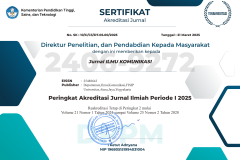Deception in Online Learning During the Pandemic of Covid-19 in Indonesia
DOI:
https://doi.org/10.24002/jik.v18i2.3764Keywords:
Deception, Computer-mediated communication, Distance learningAbstract
Computer-mediated communication on distance learning brings various effects on thelecturers and the higher-education students. Distance learning has been performed on campusesin Indonesia since the pandemic of Covid-19. This research aims to describe the students’deception via computer-mediated communication. Interpersonal deception and computer-mediated communication theories are chosen to analyze this deception phenomenon. Data were collected through questionnaires and distributed to students in Jakarta as the red zone of the pandemic ofCovid-19. The findings show the students tended to manipulate information before they deliver it tothe audience and to hide their identity or presence during the virtual classroom.
References
Bailenson, J. N., Yee, N., Blascovich, J., & Guadagno, R. E. (2008). Transformed social interaction in mediated interpersonal communication. Mediated Interpersonal Communication, 77–99. https://doi.org/10.4324/9780203926864
Beldarrain, Y. (2006). Distance education trends: Integrating new technologies to foster student interaction and collaboration. Distance Education, 27(2), 139–153. https://doi.org/10.1080/01587910600789498
Boulos, M. N. K., Taylor, A. D., & Breton, A. (2005). A synchronous communication experiment within an online distance learning program: A case study. Telemedicine Journal and E-Health, 11(5), 583–593. https://doi.org/10.1089/tmj.2005.11.583
Burgoon, J. K., Bonito, J. A., & Dunbar, N. E. (2003). Trust and Deception in Mediated Communication Gates Matthew Stoner. Proceedings of the 36th Hawaii International Conference on System Sciences, 1–11. https://doi.org/10.1109/HICSS.2003.1173792
Burgoon, J. K., & Qin, T. (2006). The dynamic nature of deceptive verbal communication. Journal of Language and Social Psychology, 25(1), 76–96. https://doi.org/10.1177/0261927X05284482
Carlson, J. R., George, J. F., & Adkins, M. (2004). Deception in Computer-Mediated Communication. 13(303), 5–28. https://doi.org/https://doi.org/10.1023/B:GRUP.0000011942.31158.d8
Chan, M. (2011). Shyness, sociability, and the role of media synchronicity in the use of computer-mediated communication for interpersonal communication. Asian Journal of Social Psychology, 14(1), 84–90. https://doi.org/10.1111/j.1467-839X.2010.01335.x
DePaulo, B. M., Kirkendol, S. E., Kashy, D. A., Wyer, M. M., & Epstein, J. A. (1996). Lying in Everyday Life. Journal of Personality and Social Psychology, 70(5), 979–995. https://doi.org/10.1037/0022-3514.70.5.979
Devito, J. A. (2011). Komnikasi Antar Manusia. Karisma Publishing Group.
Drago, E. (2015). The Effect of Technology on Face-to-Face Communication. Elon Journal of Undergraduate Research in Communication, 6(1). Retrieved from http://www.inquiriesjournal.com/a?id=1137
Griffin, E. (2006). A First Look at Communication Theory. McGraw-Hill International.
Hadi, S. (2015). Metodologi Riset. Yogyakarta: Pustaka Pelajar.
Hancock, J. T. (2007). Hancock-Ohip-Digital-Deception. In The Oxford Handbook of Internet Psychology. Oxford University Press.
Hancock, J. T., & Gonzales, A. (2003). Deception in computer-mediated communication.
Hancock, J. T., Thom-Santelli, J., & Ritchie, T. (2004). Deception and design: The impact of communication technology on lying behavior. Conference on Human Factors in Computing Systems - Proceedings, 6(1), 129–134.
Ho, S. M., Lowry, P. B., Warkentin, M., Yang, Y., & Hollister, J. M. (2017). Gender deception in asynchronous online communication: A path analysis. Information Processing and Management, 53(1), 21–41. https://doi.org/10.1016/j.ipm.2016.06.004
Hrastinski, S. (2008). Asynchronous & Synchronous E-learning. Educause Quarterly, (4).
Jayani, D. H. (2020). 10 Media Sosial Yang Paling Sering Digunakan di Indonesia. Retrieved from databoks.katadata.co.id website: https://databoks.katadata.co.id/datapublish/2020/02/26/10-media-sosial-yang-paling-sering-digunakan-di-indonesia
Kdouh, A. M. (2017). An Investigation of Electronic versus Face-to-Face Interpersonal Communication between Administrators and Faculty in Higher Education. San Diego University, California.
Malin, C. H., Gudaitis, T., Holt, T. J., & Kilger, M. (2017). Deception in the digital age: Exploiting and defending human targets through computer-mediated communications. In Deception in the digital age: Exploiting and defending human targets through computer-mediated communications. Retrieved from https://books.google.com/books?hl=en&lr=&id=TnEmDwAAQBAJ&oi=fnd&pg=PP1&dq=virtual+reality+redirection+%22change+blindness%22&ots=zO9UpiEoAO&sig=MK8X2QuwWADrXHgwk7z2XBiT-ko
Mubdi, U. (n.d.). Pandemi Covid-19 dan Keamanan Internasional. Retrieved from Suara.com website: https://www.suara.com/yoursay/2020/05/14/131054/pandemi-covid-19-dan-keamanan-internasional
Nasional, G. T. (n.d.). Pasien Sembuh Covid-19 Kembali Naik Jadi 3.803, Kasus Positif Bertambah 490 orang. Retrieved from Covid19.go.id website: https://covid19.go.id/p/berita/pasien-sembuh-covid-19-kembali-naik-jadi-3803-kasus-positif-bertambah-490-orang
Prabakaran, K. (2020). Creating Awareness on Digital Stress During Emerging Contemporary Issues on Coronavirus Disease Circumstances: a review. Journal of Xi’an University of Architecture & Technology, 12(4).
Sugiyono. (2015). Metode Penelitian Pendidikan: Pendekatan Kuantitatif, Kualitatif, dan R & D. Bandung: CV Alfabeta.
Vonderwell, S. (2003). An examination of asynchronous communication experiences and perspectives of students in an online course: A case study. Internet and Higher Education, 6(1), 77–90. https://doi.org/10.1016/S1096-7516(02)00164-1
Whiteman, J. A. M. (2002). Interpersonal communication in computer mediated learning. Retrieved from https://libproxy.library.unt.edu:9443/login?url=http://search.ebscohost.com/login.aspx?direct=true&db=eric&AN=ED465997&site=ehost-live&scope=site
Whittaker, S. (2003). Theories and methods in mediated communication. In Computer (Vol. 18). Retrieved from http://eprints.whiterose.ac.uk/8429/
Downloads
Published
Versions
- 2022-11-03 (2)
- 2021-12-14 (1)
How to Cite
Issue
Section
License
Copyright (c) 2021 Jurnal ILMU KOMUNIKASI

This work is licensed under a Creative Commons Attribution 4.0 International License.
Jurnal ILMU KOMUNIKASI is an academic journal. As such, it is dedicated to the open exchange of information. For this reason, JIK is freely available to individuals and institutions. Authors who publish in Jurnal ILMU KOMUNIKASI will release their articles under the Creative Commons Attribution (BY) License. This license allows anyone to copy and redistribute the article in any medium or format as well as remix, transform, and build upon the material for any purpose, even commercially as long as they credit the authors for the original creation. For details of the rights authors grants users of their work, see the "human-readable summary" of the license, with a link to the full license. (Note that "you" refers to a user, not an author, in the summary)
 This work is licensed under a Creative Commons Attribution 4.0 International License.
This work is licensed under a Creative Commons Attribution 4.0 International License.














